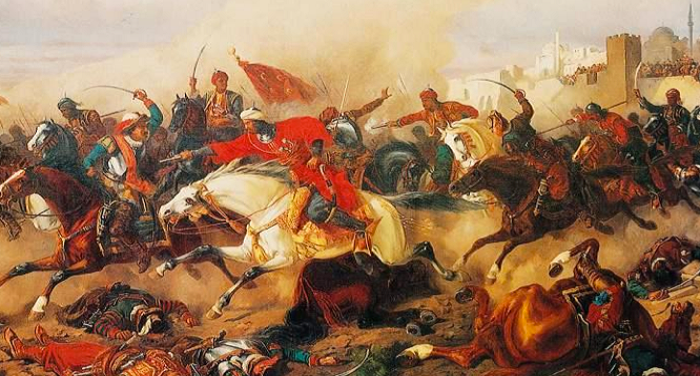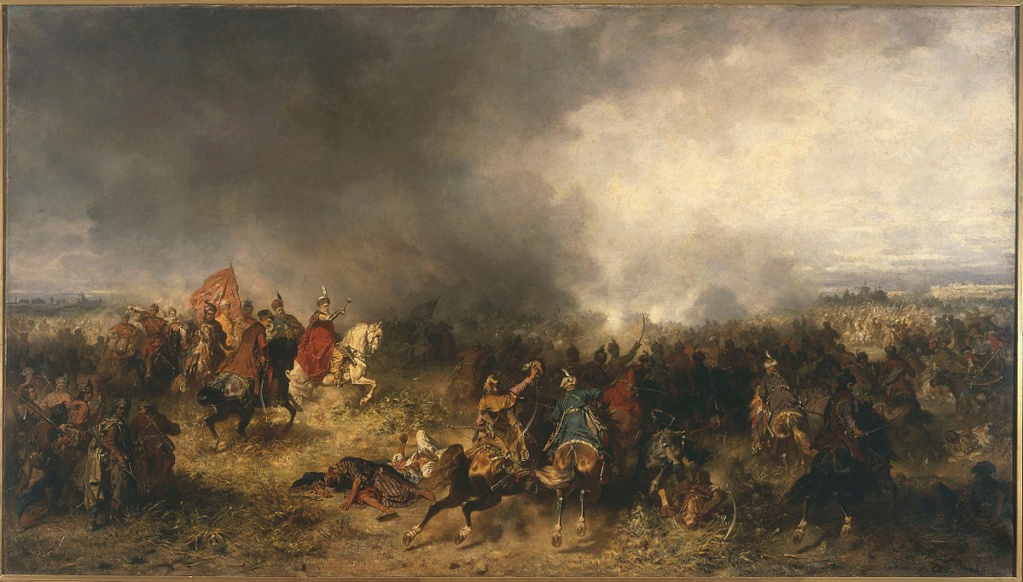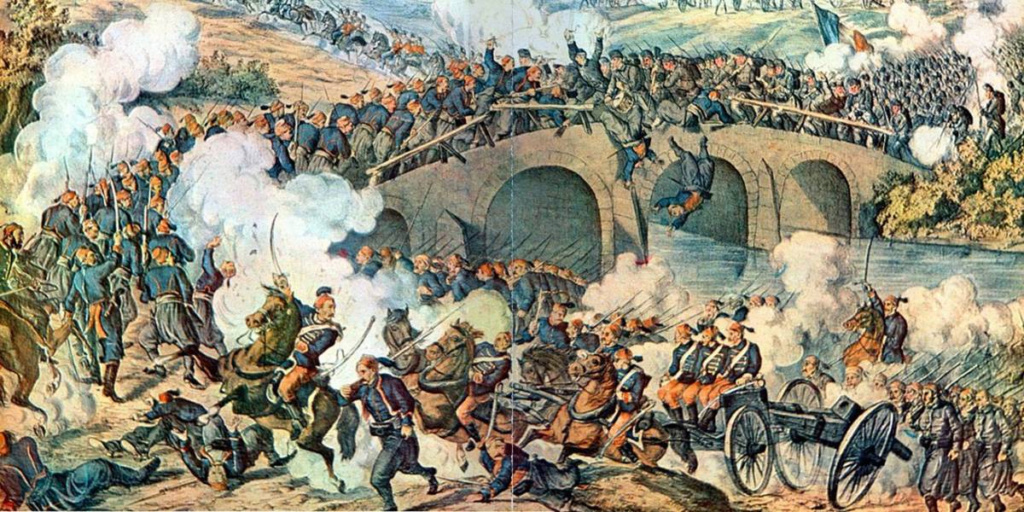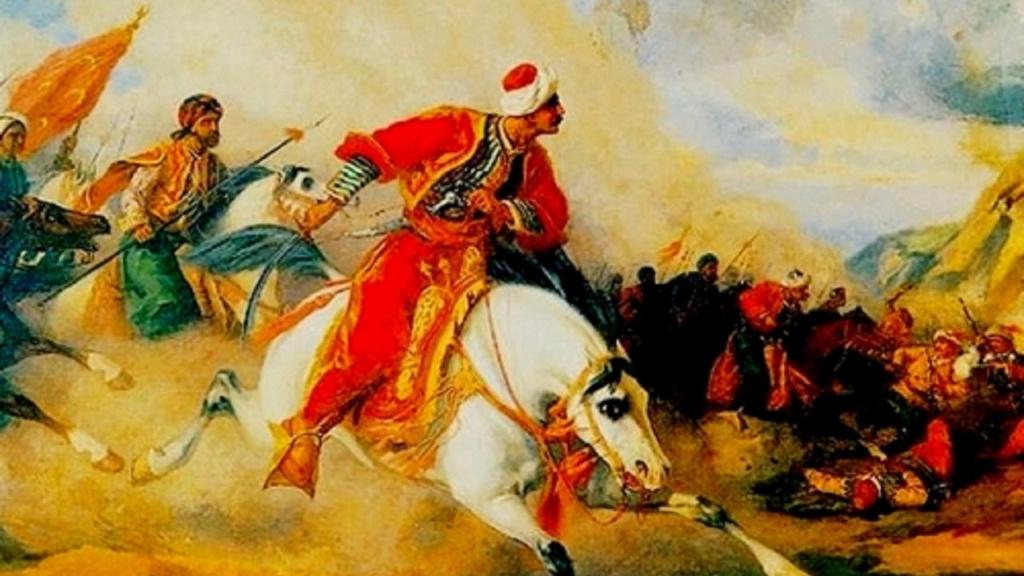The battle of "Marj Dabiq", when the Ottomans defeated the Mamluks and expanded in the islamic world
The battle of "Marj Dabiq" is considered a battle of great influence on the Islamic world. It was the war of the Mamluks and the Ottomans, and its leaders were Sultan Selim I of the Ottoman Empire and Sultan Qanswa al-Ghouri, the leader of the Mamluks.

The battle of "Marj Dabiq" is considered a battle that has a strong impact on the Islamic world, as it was not between a Byzantine and Islamic power, for example, and it was not part of the Crusades that affected the Arab and Islamic world for two centuries. Rather, it was an Islamic-Islamic battle in which the Mamluks and Ottomans fought. It was led by Sultan Selim I of the Ottoman Empire and Sultan Qanswa al-Ghuri, the leader of the Mamluks.
And after MBC announced the presentation of the series "Kingdoms of Fire", which deals with this battle and the details surrounding it, this report will return with you to history to explain to you some of the details surrounding the battle and its results.

The Mamluks and the Ottomans before the Battle of "Marj Dabiq"
After Sultan Selim I secured the borders of the Ottoman Empire from the eastern and western sides, he can now turn his attention to the southeast, where the ancient Mamluk Sultanate was dominant over Egypt, the Levant, and the Jazira.
The Ottomans had taken control of Constantinople, the capital of the Byzantine state, which became Istanbul in 1453, and they took it as their capital. East instead of West, is Sultan Selim I.
In the early 16th century, the Ottoman Empire had already conquered most of the Balkans, which is located in the southern part of Europe, and turned its attention to the Middle East.
The primary driver behind this was the fear of the influence of the rapidly expanding Persian Safavid Empire. The Safavid Empire originated in 1501 in what is today the East Azerbaijan Province in northern Iran, and soon expanded to include much of Persia, Afghanistan and Iraq.
The Safavid state had a tremendous impact on many Turkish and Kurdish tribes in eastern Turkey, many of them were influenced by the Shiite propaganda of the Safavids, and in order to counter this huge destabilizing influence on the eastern side, the Ottomans moved to confront the Safavids directly, and this led to the pivotal battle of "Caldiran" On August 23, 1514, which resulted in an Ottoman victory, aided by superior artillery.
Galdiran consolidated Ottoman rule over eastern Turkey and Mesopotamia and restricted Safavid expansion mostly to Persia. This also halted the expansion of Shiite Islam, and Sunni Islam, defended by the Ottomans, maintained its permanent dominance over most of the region.
The Battle of Chaldiran soon led to another pivotal battle in the region. After the Ottoman Sultan secured his eastern empire, he could turn his attention to the southwest, where the Mamluk Sultanate was dominant.
The Mamluk Sultanate was the dominant power in the Islamic world for more than 250 years, as it ruled in Egypt and the holy cities of Makkah, Madinah, and Jerusalem, and the rest of the coast and cities of the Levant. They killed the Abbasid Caliph in Baghdad.

The clash between the Ottomans and the Safavids
However, the Mamluks were able, through many internal and external battles and conflicts, to establish their state in Egypt, which extended to include the entire Levant, according to the book “The History of the Mamluks in Egypt and the Levant ” by historian Muhammad Suhail Taqqosh.
The Mamluk sultanate in Egypt was established in 1250 by a group of slave soldiers (that is why they were called Mamluks) who took power from the Saladin dynasty, and by early 1500 their rule was slowly beginning to decline.
The Islamic world was shared by three relatively large and powerful states: the Mamluks in Egypt and the Levant, the Ottomans in present-day Turkey, the Balkans and Central Asia, and the Safavids in present-day Iran and East Asia.
The Ottomans greatly feared the possibility of an alliance between the Mamluks and the Safavids. After the battle of "Caldiran" in which the Safavids were defeated, they concluded what appears to be a defensive agreement with the Mamluks, according to which if the Ottomans invaded Persia again, the Mamluks would move north to Turkey via Syria, This prompted the Ottomans to preemptively attack the Mamluk Sultanate in 1516.
The message that ignited the war of the Mamluks and Ottomans
When Sultan Selim I learned about the Mamluk moves that Sultan Qanswa al-Ghuri had taken, some moves appeared from him that assured the Mamluks that Selim decided to march to the Levant and Egypt, and meet the Mamluks in a decisive battle.
Sultan Qanswa Al-Ghouri sent a message to Sultan Selim in an attempt to calm things down, but Sultan Selim’s response was decisive, and this is part of the message:
Our high determination and strong determination were directed to the eastern lands (he means the Shiite Safavid state in Iran) to revive the glorious Sharia, but it became clear to us some of your inappropriate behavior, which you intended to strengthen this corrupt atheist (Sultan of the Safavids) with bad habits who does not adhere to religion, so I meant To you ourselves, because you are worse than him, we crossed houses and stages towards you with countless soldiers and banners of conquest, signs of victory, we entered kingdoms under your rule and seized them, and he was sent to you at the outskirts of Wadi Tojan.
If you have an iota of zeal, a measure of manliness, a share of bullying, and a special courage and courage in your heart, then do not fall into the corner of fear and terror, and prepare yourself and all your aides and supporters, and do not run away from the wound of the sword.
Sultan Qanswa Al-Ghouri was enraged by Sultan Selim I's response, and by the strong-worded threatening message, and began preparing his armies, arranging the ranks of his soldiers, and moving to the Marj Dabiq area in northwest Syria in preparation for a bloody decisive encounter with Selim I.

Sultan Qanswa Al-Ghouri
The Mamluk army was less efficient than the Ottoman army, as the Mamluk state was in the era of its decline and self-sufficiency, and its internal conflicts, not only this, as Sultan Qanswa Al-Ghouri was at odds with the Caliph in Baghdad, and also, he was arrogant, not Qanswa is the leader himself. Who defeated the Portuguese fleet in the naval battle of "Saul" when they tried to control the Red Sea.
Sultan Selim I and his armies arrived in the Dabiq area, which is located north of the city of Aleppo and belongs to the Syrian province of Aleppo, and we call that the war tomorrow , and here Sultan Selim I gave his famous sermon to his soldiers:
Tomorrow everything will be clear, God is with us, we trust our soldiers. The factions that won us victory in “Caldiran” (the battle in which they defeated the Safavids) will raise their flags here too, and my ministers and princes What I ask of you is that you fight at the head of your soldiers, urge them to be heroic and courageous, as for me, I will not delay you, and God martyr.
Ottoman artillery and treachery eliminate Sultan Qanswa al-Ghouri
The historian Ibn Iyas, in his book “ Bada’i al-Zuhur fi Qaqa’i al -Daur,” depicts the Mamluk army as follows. “Al-Ghouri appeared in the fighting procession on his horse, and around him was a group of nobles carrying on their heads forty copies of the Qur’an in bags of yellow silk, including one in the Caliph’s handwriting. The third Rashid, Othman bin Affan, in addition to tens of thousands of soldiers.
Matrakji Nasouh, one of the historians of the Ottoman Empire, describes in his manuscript “Fatahnama Diyar Arab” that the Ottoman army brought with him 300 cannons, and the number of soldiers amounted to about 60 thousand soldiers.
The two armies met on August 24, 1516. In this battle, the Mamluks showed stiff resistance, although their military capabilities were modest. But the dispute soon broke out between the fighting Mamluk teams, and some of them sided with the Ottoman army led by Khayir Bey, one of the Circassian Mamluk princes.
Khayir Bey rumored among the ranks of the Mamluk army that Sultan Qanswa Al-Ghouri had ordered Jalabanah, - one of the Mamluk army divisions, and the Sultan used to buy them for himself - not to fight until he issued his orders to them, and until the Qaranis fought alone - the Qaranis were the ancient Mamluks -.
Because of this rumor, Al-Qaranis died in the war, and they saw that they were victims of a despicable plan on the part of the Sultan, who wanted to make them easy prey for the fire of the Ottomans’ cannons. Then Khayir Bey spread another rumor among the army, saying that Sultan Qanswa Al-Ghouri himself had been killed, according to the historian Ibn Zanbul. Al- Rammal , an Egyptian Muslim historian who lived in the fifteenth century, and Khayir Bey kept telling the soldiers, “Flee, flee, for the Sultan was intact and surrounded you, and Al-Ghouri was killed, and the shard is upon us.”
Al-Ghouri was still alive, and he kept repeating to the ranks of the fleeing army: "Oh, Aghas! This is the time for chivalry, this is the time for help, O Aghas of courage, be patient for an hour!" But no one listened to him, and they kept withdrawing around him, for the legend of the strong Sultan Qansouh had gone from their imagination.
According to the book “The Ottoman Conquest of Levant and Egypt, ” Al-Ghouri tried to escape, but the seventy-year-old Sultan fell from his horse after a few steps, as a lifeless body from the horror of defeat, and when his body was found, his head was cut off and presented to Sultan Selim.

Painting of Sultan Selim I in battle
The main factor in the Ottoman victory was mastery of a new military technology: cannons, they brought with them 300 cannons, as mentioned. The Mamluk forces were excessively dependent on the cavalry, as they relied on it completely to win the battle, which did not withstand the fire of the cannons, and the rumors spread by Khayr Bey increased the frustration and division of the army, which led to the army’s flight. Eight hours after the start of the fight.
The Mamluk Sultanate collapsed shortly after the "Marj Dabiq", with the continuation of the Ottoman victory in the Battle of "Al-Raydania" later on January 22, 1517, which took place between Tuman Bey, the last Mamluk sultan in Egypt and the nephew of Sultan Qanswa Al-Ghouri and the Ottoman Sultan Selim I as well. Egypt became part of the Ottoman Empire.
The control of the Hejaz was also transferred to the Ottomans, as the Sharif of Mecca transferred his loyalty from the Mamluks to the Ottoman sultans.
https://arabicpost.net/%D8%AB%D9%82%D8%A7%D9%81%D8%A9/2019/11/20/%D9%85%D8%B9%D8%B1%D9%83%D8%A9-%D9%85%D8%B1%D8%AC-%D8%AF%D8%A7%D8%A8%D9%82-%D8%A7%D9%84%D9%85%D9%85%D8%A7%D9%84%D9%8A%D9%83-%D9%88%D8%A7%D9%84%D8%B9%D8%AB%D9%85%D8%A7%D9%86%D9%8A%D9%8A%D9%86/

